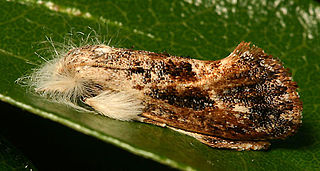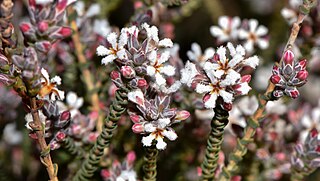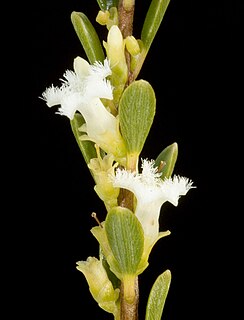
Leucopogon is a genus of about 150-160 species of shrubs or small trees in the family Ericaceae, in the section of that family formerly treated as the separate family Epacridaceae. They are native to Australia, New Zealand, New Caledonia, the western Pacific Islands and Malaysia, with the greatest species diversity in southeastern Australia. Plants in this genus have leaves with a few more or less parallel veins, and tube-shaped flowers usually with a white beard inside.

The white-chinned prinia, also known as the white-chinned warbler, is a species of bird in the family Cisticolidae.

The spot-bellied bobwhite is a ground-dwelling bird in the New World quail family. It is sometimes considered to be conspecific with the crested bobwhite, Colinus cristatus. As the latter species expands north into Costa Rica, it is likely that the two species will overlap in range in the future, but the Costa Rican subspecies of the spot-bellied is the least similar to the crested.

Acrolophus is a genus of moths in the family Acrolophidae, with, typically, great individual variation within species in color pattern, making field identification of many individuals difficult or impossible. It was described by Felipe Poey in 1832.

Leucopogon parviflorus, commonly known as coast beard-heath or native currant, is a shrub or small tree in the family Ericaceae. It is native to Australia and New Zealand.

Leucopogon fasciculatus, the tall mingimingi, is a species of shrub within the family Ericaceae. It is endemic to New Zealand. This species is found in the North Island north of the Bay of Plenty and Taranaki. In the South Island it is found in north west Nelson. It is present in the red and silver beech forests admixed with rimu and miro podocarps on northern South Island.

Acrolophus popeanella is a moth of the family Acrolophidae. It is found in the eastern United States, from New Jersey and Ohio south to Florida and west to Illinois, Nebraska and Texas.
Acrolophus fervidus is a moth of the family Acrolophidae described by August Busck in 1912. It is found in Costa Rica, Mexico and Texas.

The grass tubeworm or Texas grass tubeworm moth is a moth of the family Acrolophidae. It is found from Maryland to Florida and to Texas.
Acrolophus macrogaster is a moth of the family Acrolophidae. It is found in North America, including Arizona.
Walsingham's grass tubeworm moth is a moth of the family Acrolophidae. It is found in North America, including Alabama, Florida, Georgia, Illinois, Louisiana, Maryland, Mississippi, New York, Ohio, South Carolina, Tennessee, Virginia and West Virginia.
Acrolophus echinon is a moth of the family Acrolophidae. It is found in Mexico.
Acrolophus walsinghami is a moth of the family Acrolophidae. It is found in Puerto Rico.
Persoonia leucopogon is a shrub native to Western Australia.

Leucopogon sprengelioides is an erect shrub in the family Ericaceae found in Western Australia, where it grows on granite outcrops and hill, ridges and breakaways and on coastal limestone. It grows to a height of 0.2 - 0.8 m and its white flowers may be seen from March to April or July to November.

Leucopogon pulchellus, commonly known as coast beard-heath, is a shrub in the family Ericaceae, native to the south west of Western Australia. It grows to heights between 15 cm and 1.5 m, generally on lateritic or granitic soils, and its white flowers may be seen from June or November or from January to February.

Leucopogon plumuliflorus is a shrub in the family Ericaceae. It is endemic to Western Australia.

Leucopogon tamminensis is a shrub in the family Ericaceae found in Western Australia.

Styphelia crassifolia is a plant in the family Ericaceae native to Western Australia. It was first described in 1845 as Leucopogon crassifolius by Otto Wilhelm Sonder. In 1867 Ferdinand von Mueller transferred it to the genus, Styphelia, but the accepted name continued to be Leucopogon crassifolius. However in 2020, with a publication concerning the phylogeny of Styphelia by Crayn and others, the name Styphelia crassifolia was accepted by the Herbarium of Western Australia.

Leucopogon polymorphus is a small plant in the family Ericaceae, endemic to Western Australia. It is a shrub, growing from 0.2 m to 1 m high, on sandy soils. Its white flowers may be seen from June to October.












